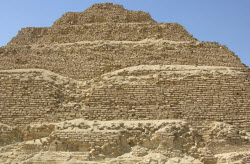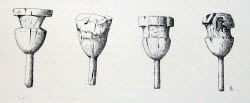| |
|
|
Egyptian Pyramid Saqqara
 Saqqara is an area of Egypt used as a burial ground used by pharaohs and people of nobility in the first Egyptian Dynasty. It is a necropolis, a large cemetery, or sometimes called the 'City of the Dead'. The northern entrance of Saqqara is located right at the start of the Nile delta. At the time the Egyptian capital was located in Memphis and Saqqara was built to the west of Memphis where today you can see a few pyramids constructed by the early pharaohs of the first dynasty. The burial site was built on a plateau and extends 4 miles from the northern entrance to southern end of Saqqara.
More..
Saqqara is an area of Egypt used as a burial ground used by pharaohs and people of nobility in the first Egyptian Dynasty. It is a necropolis, a large cemetery, or sometimes called the 'City of the Dead'. The northern entrance of Saqqara is located right at the start of the Nile delta. At the time the Egyptian capital was located in Memphis and Saqqara was built to the west of Memphis where today you can see a few pyramids constructed by the early pharaohs of the first dynasty. The burial site was built on a plateau and extends 4 miles from the northern entrance to southern end of Saqqara.
More..
|
|
|
|
 |
|
|
Egyptian Pyramid Construction Techniques
|
In 2500 B.C., King Khufu, began the building of the tomb where his physical presence would pass on in this world. This would be the largest of all the pyramids and is located at the site of Giza. The consensus among Egyptologists estimated that this pyramid required 80 years to complete and a workforce of 30,000 in constant rotation. The Egyptians did not have any advanced equipment or machinery at the time to cut out the pyramid blocks. How did they do all this with? It took a human laborers and a lot of smart Egyptians to figure come up with a process. It was extremely difficult, but not impossible.
|
If we start first at the quarry where they excavated each of the 2.5 ton stone blocks that would make up most of the pyramid material you will notice immediately that it looks like any normal quarry. The amazing part is the Egyptian masons were able carve out the stones and shape them without the use of any machinery. Even to this date if one visits the quarry site you will still find pyramid hewn blocks that were excavated scattered throughout the site. These blocks were the roughly excavated blocks that were never transported to the construction site. The only techniques at the time to excavate these immense stone blocks from the limestone rock face were the traditional chisel and hammer backed by a large workforce of masons. Everything required manual labor and required incredible number of work hours to accomplish. If there television technology back then I do not think we would be able to enjoy these breathtaking structures today.
Once the hewn blocks were chiseled out of the limestone the next question was how did they transport these massive stones from the quarry to the construction site? Again there was no pulley system equipment available then to simplify this task so again traditional man power was required to haul these stones to the construction site where the blocks would smoothed out and prepared for positioning. Each block weighed in at 2.5 tons and they were transported on wooden blank designed to slide across the floor. The Egyptians opted to cut out the blocks of this weight because they calculated it was the optimum weight to ensure maximum transportation efficiency. If the blocks were heavier it would require too much man power to transport to the pyramid constructive site. The blocks were harnessed with ropes and dragged across the floor by a team of 20-25 men. To prevent any friction that would further cause delays to the transporting the Egyptians would pour water along the floor path to allow the limestone blocks to slide easier. The water acted as a lubricant. This eased transporting the giant blocks to the site without feeling it would be a daunting task
One of the key characteristics to the Egyptian pyramid is that each additional layer that is added takes up a smaller surface area than the layer below it. The Egyptians used some form of a ramp system to drag the blocks up to the layers being built. As the construction got higher they would wrap the ramp around the pyramid. The Egyptians could not keep building a ramp directly to the pyramid and continue to increase the height of it because that would cause the ramp angle to be too steep to drag the pyramid blocks up. On the interior side where the burial chambers were constructed was no easy task either. The interior had to be built at the same time as the exterior. All the effort was again all possible using manual labor and more senior men that were in charge of guiding the blocks into position. It was an effort that required incredible feats of teamwork to accomplish. It got more complex as the pyramid got higher. The pyramids were also aligned to the four points of a compass. The Egyptians accomplished this using a curved wall that faced north. Then they would take the two points of the sun as it rose from the east and set in the west. Finally they would mark the line using a plumb line from each point of the way outwards until the lines meet one another. That point of intersection is the exact northern direction. The Egyptians were excellent in math and knew how to effectively use angles. Building the Egyptian pyramids were projects of immense proportion for that time period and most importantly could not be accomplished without the collaboration of everyone involved. The pyramids were promoted as gateways to transport the pharaoh and any worker involved in the construction to the afterlife.
More Articles :

|
|
|
|
 |
|
